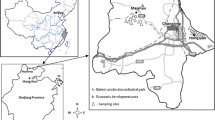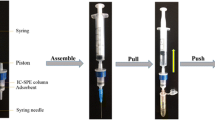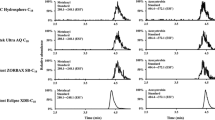Abstract
Herein, field experiment trials were conducted at two different sites (Heilongjiang and Hubei Province) in China to determine the residual levels and dissipation kinetics of metalaxyl-M in rice grains, and paddy soil and water. A modified quick, easy, cheap, effective, rugged, and safe “QuEChES” method coupled with liquid chromatography-tandem mass spectrometry (LC-MS/MS) was developed for determination of metalaxyl-M residual levels in different matrices. The method showed an excellent linear response (R2 > 0.99) over the concentration range of 0.01–0.50 mg kg−1 with satisfactory recovery rates in between 76.00 and 111.36%. The limits of quantification (LOQ) were estimated to be 0.010 mg kg−1 for all matrices. Half-lives of 0.27 to 10.83 days in rice plant, paddy soil, and water indicate that the analyte is easily degraded in the environment within a relatively short time. The terminal residues of metalaxyl-M in rice husks and rice grains were less than 0.05 mg kg−1. Dietary risk assessment showed that harvested rice treated with metalaxyl-M would not pose unreasonable risk to humans or the environment.


Similar content being viewed by others
Data availability
Not applicable. All data generated or analyzed during this study were included in this published article.
References
Abass K, Reponen P, Jalonen J, Pelkonen A (2007) In vitro metabolism and interactions of the fungicide metalaxyl in human liver preparations. Environ Toxicol Pharmacol 23(1):39–47
Atmaca N, Arikan S, Essiz D, Kalender H, Simsek O, Bilmen FS, Kabakci R (2018) Effects of mancozeb, metalaxyl and tebuconazole on steroid production by bovine luteal cells in vitro. Environ Toxicol Pharmacol 59:114–118
Boobis AR, Ossendorp BC, Banasiak U, Hamey PY, Sebestyen I, Moretto A (2008) Cumulative risk assessment of pesticide residues in food. Toxicol Lett 180(2):137–150
Jimenez JJ, Bernal JL, del Nozal MJ, Bernal J, Toribio L (2007) Persistence and degradation of metalaxyl, lindane, fenvalerate and deltamethrin during the wine making process. Food Chem 104(1):216–223
Jing X, Yao G, Wang P, Liu D, Qi Y, Zhou Z (2016) Enantioselective degradation and chiral stability of metalaxyl-M in tomato fruits. Chirality 28(5):382–386
Karras G, Savvas D, Patakioutas G, Pomonis T, Albanis T, Pomonis P (2007) Modelling the transport of metalaxyl in gerbera plants grown in a closed-loop hydroponic system. Biosyst Eng 96(2):279–292
Liu CY, Wan K, Huang JX, Wang YC, Wang FH (2012) Behavior of mixed formulation of metalaxyl and dimethomorph in grape and soil under field conditions. Ecotox Environ Safe 84:112–116
Liu X, Yang Y, Cui Y, Zhu H, Li X, Li Z, Zhang K, Hu D (2014) Dissipation and residue of metalaxyl and cymoxanil in pepper and soil. Environ Monit Assess 186(8):5307–5313
Liu Y, Shen D, Li S, Ni Z, Ding M, Ye C, Tang F (2016) Residue levels and risk assessment of pesticides in nuts of China. Chemosphere 144:645–651
Malhat FM (2017) Persistence of metalaxyl residues on tomato fruit using high performance liquid chromatography and QuEChERS methodology. Arab J Chem 10:S765–S768
Massoud AH, Derbalah AS, Belal ESB (2008) Microbial detoxification of metalaxyl in aquatic system. J Environ Sci-China 20(3):262–267
Molinero-Ruiz ML, Cordon-Torres MM, Martinez-Aguilar J, Melero-Vara JM, Dominguez J (2008) Resistance to metalaxyl and to metalaxyl-M in populations of Plasmopara halstedii causing downy mildew in sunflower. Can J Plant Pathol 30(1):97–105
Monkiedje A, Spiteller M, Bester K (2003) Degradation of racemic and enantiopure metalaxyl in tropical and temperate soils. Environ Sci Technol 37(4):707–712
Monkiedje A, Spiteller M, Maniepi SJN, Sukul P (2007) Influence of metalaxyl- and mefenoxam-based fungicides on chemical and biochemical attributes of soil quality under field conditions in a southern humid forest zone of Cameroon. Soil Biol Biochem 39(4):836–842
Montes MS, Nielsen BJ, Schmidt SG, Bodker L, Kjoller R, Rosendahl S (2016) Population genetics of Phytophthora infestans in Denmark reveals dominantly clonal populations and specific alleles linked to metalaxyl-M resistance. Plant Pathol 65(5):744–753
Oliva J, Navarro S, Barba A, Navarro G (1999) Determination of chlorpyrifos, penconazole, fenarimol, vinclozolin and metalaxyl in grapes, must and wine by on-line microextraction and gas chromatography. J.Chromatogr.AJ 833(1):43–51
Ramezani MK, Shahriari D (2015) Dissipation behaviour, processing factors and risk assessment for metalaxyl in greenhouse-grown cucumber. Pest Manag Sci 71(4):579–583
Rattan GS, Sharma N (2012) Dissipation kinetics of metalaxyl in cucumber. B Environ Contam Tox 88(5):769–771
Ripley BD, Ritcey GM, Harris CR, Denomme MA, Lissemore LI (2003) Comparative persistence of pesticides on selected cultivars of specialty vegetables. J Agric Food Chem 51(5):1328–1335
Sharma KK, Tripathy V, Rao CS, Bhushan VS, Reddy KN, Jyot G, Sahoo SK, Singh B, Mandal K, Banerjee H, Banerjee T, Bhattacharya S, George T, Beevi N, Sharma K, Tayade A, Gopal M, Walia S (2019) Persistence, dissipation, and risk assessment of a combination formulation of trifloxystrobin and tebuconazole fungicides in/on tomato. Regul Toxicol Pharmacol 108:104471
Sturz AV, Peters RD (2007) Endophyte-mediated disease suppression induced by application of metalaxyl-m to potato foliage. Can J Plant Pathol 29(2):131–140
Turkolmez S, Dervis S (2017) Activity of metalaxyl-M plus mancozeb, fosetyl-Al, and phosphorous acid against Phytophthora crown and root rot of apricot and cherry caused by Phytophthora palmivora. Plant Prot Sci 53(4):216–225
Wang MY, Zhang Q, Cong LJ, Yin W, Wang MH (2014) Enantioselective degradation of metalaxyl in cucumber, cabbage, spinach and pakchoi. Chemosphere 95:241–246
Wang XR, Zhu WT, Qiu J, Zhang P, Wang Y, Zhou ZQ (2016) Enantioselective metabolism and toxic effects of metalaxyl on primary hepatocytes from rat. Environ Sci Pollut Res 23(18):18649–18656
Wang C, Yang Z, Tang LH, Wang XM, Zhang Q (2018) Potential risk and mechanism of microcystin induction by chiral metalaxyl. Environ Sci Technol Letters 5(11):635–640
Wang H, Sun P, Zhang X, Wang L, Wang J (2019a) Method validation and dissipation kinetics of the new HPPD inhibitor QYR301 in rice, paddy water and paddy soil using a QuEChERS-based method and LC-MS/MS. Ecotox Environ Safe 184:109563
Wang FH, Zhou TT, Zhu LS, Wang XG, Wang J, Wang JH, Du ZK, Li B (2019b) Effects of successive metalaxyl application on soil microorganisms and the residue dynamics. Ecol Indic 103:194–201
White DJ, Chen WD, Schroeder KL (2019) Assessing the contribution of ethaboxam in seed treatment cocktails for the management of metalaxyl-resistant Pythium ultimum var. ultimum in Pacific Northwest spring wheat production. Crop Prot 115:7–12
Yang Y, Liu XY, Zhu HJ, Li ZR, Cui Y, Zhang KK, Hu DY (2015) Determination of metalaxyl in potatoes and soil by dispersive solid-phase extraction and high-performance liquid chromatography. Instrum Sci Technol 43(1):53–64
Yue H, Fang S, Zhang YZ, Ning Y, Yu WS, Kong FY, Qiu J (2016) Enantioselective effects of metalaxyl on soil enzyme activity. Chirality 28(12):771–777
Zhang P, Zhu WT, Wang DZ, Yan J, Wang Y, He L (2017) Enantioselective effects of metalaxyl enantiomers on breast cancer cells metabolic profiling using HPLC-QTOF-based metabolomics. Int J Mol Sci 18(1):23–28
Funding
This work was supported by the Beijing Excellent Talents Funding for Youth Scientist Innovation Team (2016000026833TD01), High-level Teachers in Beijing Municipal Universities (IDHT20180506), China Agriculture Research System (NO. CARS-05-05A-03), Guangxi Innovation-driven Development Project (AA17204043-2), and Central Public-interest Scientific Institution Basal Research Fund (NO.1610072016009). Ability building of scientific and technological innovation service -Basic research business expenses (No.PXM2020_014213_000017). Beijing Excellent Talents Funding for Youth Scientist Innovation Team (2016000026833TD01). High-level Teachers in Beijing Municipal Universities (IDHT20180506).
Author information
Authors and Affiliations
Contributions
Yahui He and Tangwei Zhang developed the analytic method of metalaxyl-M in rice. Xun Jiao and Mengqiang Wang performed field trials of this study. Yongxin She analyzed and interpreted the dissipation pattern and risk assessment of metalaxyl-M. Majid Khan and Muhammad Rafiullah Khan were major contributor in writing the manuscript. All authors read and approved the final manuscript.
Corresponding authors
Ethics declarations
Conflict of interest
The authors declare that they have no conflict of interest.
Ethics approval and consent to participate
Not applicable. Because manuscript did not report on or involve the use of any animal or human data or tissue.
Consent to publish
Not applicable. Our manuscript did not contain data from any individual person.
Additional information
Responsible editor: Philippe Garrigues
Publisher’s note
Springer Nature remains neutral with regard to jurisdictional claims in published maps and institutional affiliations.
Rights and permissions
About this article
Cite this article
He, Y., Jiao, X., Zhang, T. et al. Study on the dissipation pattern and risk assessment of metalaxyl-M in rice grains and paddy soil and water by liquid chromatography-tandem mass spectrometry. Environ Sci Pollut Res 28, 4245–4252 (2021). https://doi.org/10.1007/s11356-020-10802-3
Received:
Accepted:
Published:
Issue Date:
DOI: https://doi.org/10.1007/s11356-020-10802-3




